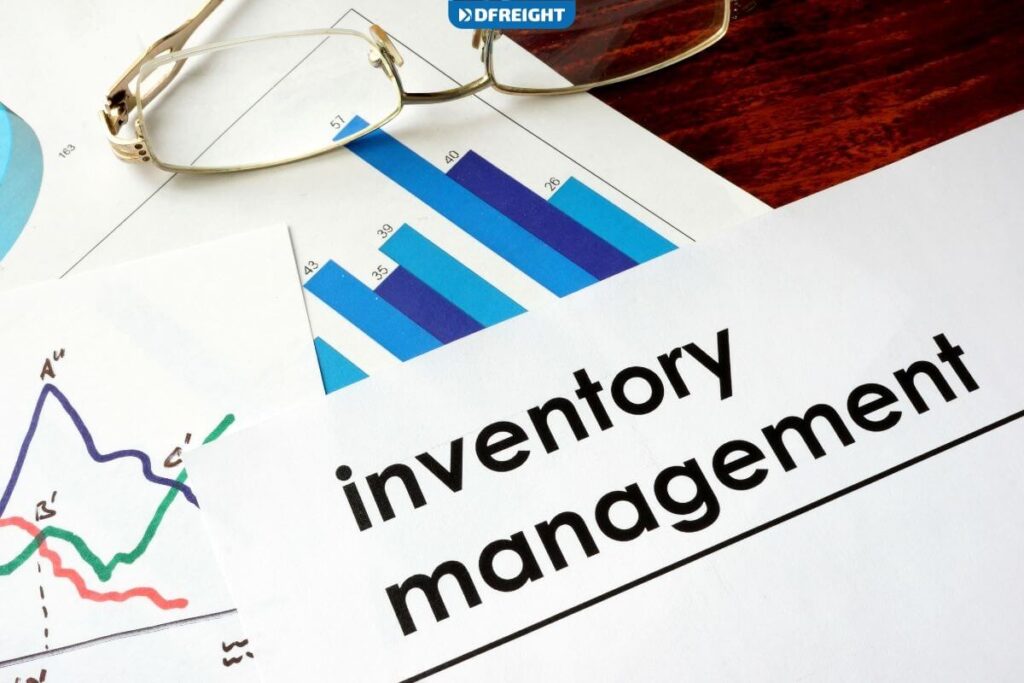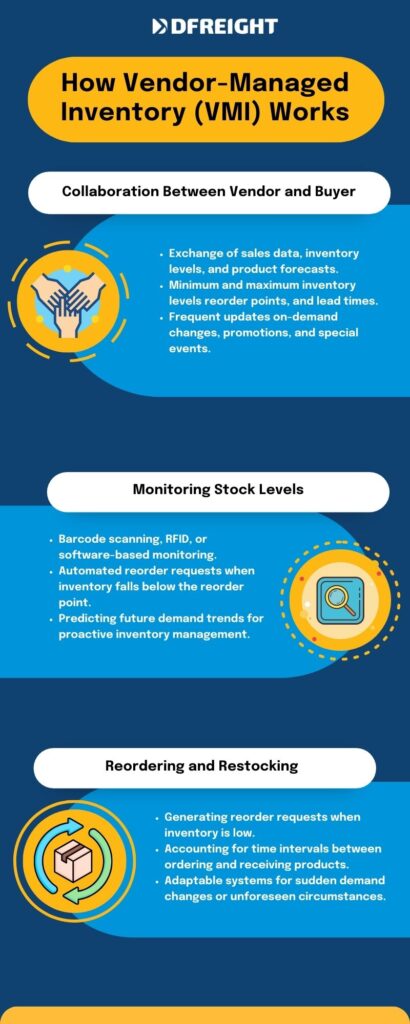In today’s fast-paced world of business, keeping track of inventory can be a daunting task. But fear not! Vendor-Managed Inventory, often abbreviated as VMI, is here to simplify this process and make it easier for businesses to manage their goods efficiently. This section will discuss Vendor-Managed Inventory and why it is significant in supply chain management.
Ready to streamline your shipping and logistics needs? Choose DFreight, the best freight forwarder in Dubai. Get started today!
Table of Contents
What is Vendor-Managed Inventory?
Vendor-Managed Inventory, or VMI for short, is a collaborative approach to inventory management between a buyer (typically a retailer or a manufacturer) and their supplier or vendor. Instead of the buyer solely overseeing and restocking their inventory, the responsibility is shared with the supplier. In simpler terms, it’s like having a helping hand from your supplier to ensure you always have the right products at the right time.
Why is Vendor-Managed Inventory Important?
Vendor-managed inventory is vital for several reasons:
- Efficiency: It streamlines the inventory management process, reducing the time and effort required to monitor stock levels and reorder products. This means less hassle for businesses and more focus on their core operations.
- Cost Savings: By optimizing inventory levels and reducing the risk of overstocking or stockouts, VMI helps cut costs associated with excess inventory or lost sales due to insufficient stock.
- Enhanced Customer Satisfaction: With VMI, businesses can ensure that popular products are always available for customers. This leads to higher customer loyalty and satisfaction.
- Improved Collaboration: VMI fosters closer collaboration between buyers and suppliers. Clear communication and shared responsibility help in avoiding misunderstandings and supply chain disruptions.
- Better Forecasting: Vendors often have access to data and insights that can aid in accurate demand forecasting. This can further optimize inventory levels and improve the overall supply chain.
Vendor-managed inventory is like having a dependable partner who helps you maintain optimal inventory levels, save money, keep customers happy, and streamline your business operations. It’s an essential tool in the modern world of inventory management.

Benefits of Vendor-Managed Inventory
Vendor-Managed Inventory (VMI) brings many advantages to businesses, simplifying inventory management while improving efficiency and cost-effectiveness. In this section, we’ll explore some of the key benefits of VMI.
1. Saving Time and Effort
Managing inventory can be a time-consuming and labor-intensive task. With VMI, a significant burden is lifted off your shoulders. Here’s how it helps save time and effort:
- Automated Reordering: VMI systems are often automated, so they can automatically monitor stock levels and trigger reorder requests. This eliminates the need for manual tracking and ordering, saving valuable time.
- Reduced Administrative Tasks: VMI reduces inventory management’s paperwork and administrative tasks. This allows your team to focus on more strategic aspects of your business.
- Streamlined Processes: VMI streamlines inventory-related processes, making them more efficient and less prone to errors. This means less time spent correcting mistakes or addressing stock-related issues.
2. Lowering Costs
Cost control is a crucial aspect of any business. VMI plays a significant role in helping businesses lower costs in several ways:
- Optimized Inventory Levels: VMI helps maintain optimal inventory levels, preventing overstocking and stockouts. This means you’re not tying up excess capital in unsold goods or losing sales due to inadequate stock.
- Reduced Holding Costs: When inventory levels are optimized, holding costs, including warehousing and storage expenses, are minimized. You’ll save money by not storing unnecessary inventory.
- Preventing Rush Orders: With VMI, you can reduce the need for costly last-minute rush orders to replenish stock. This saves on expedited shipping fees and reduces the risk of higher-priced emergency restocking.
3. Reducing Stockouts and Overstocking
Stockouts (running out of a product) and overstocking (holding too much inventory) are common headaches in inventory management. VMI addresses these issues effectively:
- Minimizing Stockouts: VMI systems continuously monitor inventory levels and reorder when necessary. This proactive approach ensures that popular products are consistently available, reducing the risk of stockouts and the associated loss of sales.
- Avoiding Overstocking: By closely aligning inventory levels with actual demand, VMI helps prevent overstocking, which ties up capital and storage space. This, in turn, reduces the need for markdowns or discounts to clear excess inventory.
In summary, Vendor-Managed Inventory simplifies inventory management, saves time and effort, lowers costs, and ensures that your shelves are neither empty nor overcrowded. It’s a strategy that enhances efficiency and profitability while keeping customers satisfied.

How Vendor-Managed Inventory Works
Understanding how Vendor-Managed Inventory (VMI) operates is essential to grasp its effectiveness in streamlining inventory management. In this section, we’ll explore the key components of how VMI works.
In essence, Vendor-Managed Inventory is a symbiotic relationship between the buyer and the vendor, enabled by data sharing and real-time monitoring. It ensures that the right products are reordered at the right time, optimizing inventory management and contributing to smoother supply chain operations.
Steps to Implement Vendor-Managed Inventory
Implementing Vendor-Managed Inventory (VMI) requires a systematic approach to ensure a successful collaboration between the buyer and the vendor. Here are the key steps to follow when implementing VMI:
Step 1: Establish Communication
Effective communication is the cornerstone of a successful VMI program. In this step, the buyer and vendor need to establish clear and open lines of communication:
- Initial Meeting: Start with an introductory meeting between the buyer and the vendor. Discuss the objectives, expectations, and benefits of implementing VMI. Ensure that both parties are aligned with the goals.
- Data Sharing: Agree on the data shared between the buyer and vendor. This includes sales data, inventory levels, and any other relevant information. Decide how frequently this data will be exchanged.
- Responsibilities: Clearly define the roles and responsibilities of each party. Outline who will monitor stock levels, generate orders, and manage inventory-related tasks.
Step 2: Set Inventory Levels
Setting optimal inventory levels is crucial to the success of VMI. It involves determining the right balance between holding enough stock to meet customer demand and avoiding overstocking. Here’s how to proceed:
- Data Analysis: Analyze historical sales data and demand patterns to identify the appropriate minimum and maximum inventory levels for each product.
- Reorder Points: Define reorder points for each product. These are the inventory levels at which the system should trigger an automatic reorder. Reorder points are typically set just above the minimum inventory level.
- Lead Times: Consider lead times, the time it takes for the vendor to process and deliver an order. Ensure that inventory is replenished promptly to avoid stockouts.
Step 3: Monitor and Adjust
Once VMI is up and running, continuous monitoring and adjustment are essential to ensure its effectiveness. This step involves ongoing management of the VMI system:
- Real-Time Monitoring: Utilize the chosen technology (e.g., barcode scanning, RFID, or inventory management software) to monitor inventory levels in real-time. This ensures that both the buyer and vendor have access to up-to-date information.
- Review and Analysis: Regularly review the VMI system’s performance. Assess whether it is meeting the predefined inventory levels, and if not, investigate the reasons for deviations.
- Adjustments: Be prepared to make adjustments as needed. If there are changes in demand patterns, seasonality, or other factors, update inventory levels, reorder points, or other parameters accordingly.
- Collaborative Feedback: Maintain open communication between the buyer and vendor. Share insights, feedback, and suggestions for improvements to the VMI process.
By following these steps to implement Vendor-Managed Inventory, businesses can enhance their inventory management efficiency, reduce costs, and ensure that products are readily available to meet customer demand. It’s a collaborative approach that benefits both the buyer and the vendor.
At DFeight, we’ve prepared much inventory-related information just for you. Discover them below:
| Our blog posts related to Inventory |
| Inventory Management Process |
| Just in Time Inventory Management |
| Inventory Planning in Business |
| ABC Analysis in Inventory Management |
Common Challenges and Solutions in Vendor-Managed Inventory
While Vendor-Managed Inventory (VMI) offers many benefits, it’s not without its challenges. Here are some common challenges that businesses may encounter when implementing VMI, along with solutions to address them:
1. Communication Issues
Challenge: Effective communication is the backbone of VMI, but misunderstandings, miscommunications, or breakdowns in communication can occur.
Solution:
- Clear Communication Protocols: Establish clear communication protocols from the outset. Define how data will be shared, when meetings or updates will occur, and who the key contact points are.
- Regular Check-Ins: Schedule regular check-in meetings between the buyer and vendor to discuss inventory performance, challenges, and opportunities. This fosters ongoing collaboration and ensures issues are addressed promptly.
- Use Technology: Leverage technology to facilitate communication. Collaborative software, messaging apps, or shared online platforms can help streamline information exchange.
2. Inventory Accuracy
Challenge: Maintaining accurate inventory data is crucial for VMI’s success. Inaccuracies can lead to stockouts or overstocking.
Solution:
- Invest in Technology: Implement advanced inventory tracking technologies like barcode scanners, RFID, or automated inventory management systems. These tools enhance accuracy and reduce the chances of manual errors.
- Regular Audits: Conduct routine physical inventory audits to cross-verify with the data in the VMI system. This helps identify and rectify discrepancies.
- Training and Education: Ensure that employees involved in VMI processes are properly trained in data entry and management to minimize errors.
3. Unexpected Demand
Challenge: VMI systems rely on historical data and demand forecasting, but unexpected spikes or drops in demand can occur.
Solution:
- Safety Stock: Maintain a buffer of safety stock for essential products. This extra inventory can be used to fulfill unexpected demand without causing stockouts.
- Flexible Parameters: Set flexible VMI parameters that can adapt to changing circumstances. Adjust reorder points and quantities based on real-time data and demand shifts.
- Collaborative Forecasting: Engage in collaborative forecasting with the vendor. Share insights about upcoming promotions, seasonal trends, or market changes that may impact demand.
- Emergency Orders: Have a process for emergency orders when demand surges unexpectedly. This might involve expedited shipping or alternative suppliers.
By proactively addressing these common challenges with the suggested solutions, businesses can navigate the complexities of Vendor-Managed Inventory more effectively. VMI can significantly improve inventory management, reduce costs, and enhance customer satisfaction when managed well.
Your Path to Efficient Inventory Management Starts Now
As we conclude this journey through the Vendor-Managed Inventory (VMI) world, you’ve discovered the potential to revolutionize your supply chain. Don’t miss out on the benefits of VMI:
- Simplified inventory management
- Cost savings
- Enhanced customer satisfaction
- Improved collaboration with suppliers
Ready to embark on this transformative path? Your efficient supply chain awaits!
What is Vendor-Managed Inventory (VMI)?
Vendor-Managed Inventory (VMI) is a collaborative inventory management approach where a supplier or vendor monitors and replenishes a customer’s inventory based on predefined agreements and stock levels.
How does VMI benefit businesses?
VMI benefits businesses by improving efficiency, reducing costs, minimizing stockouts and overstocking, enhancing collaboration with suppliers, and optimizing inventory levels to meet customer demand effectively.
Is VMI suitable for all types of businesses?
VMI can benefit various industries, including retail, manufacturing, and distribution. It is particularly useful for businesses with products subject to demand fluctuations or those seeking to streamline inventory management.
What technology is used in VMI systems?
VMI systems often utilize barcode scanning, RFID (Radio-Frequency Identification), and inventory management software to track inventory levels in real-time, facilitating automated ordering and data exchange between the buyer and vendor.
What are the common challenges in implementing VMI?
Common challenges include communication between the buyer and vendor, maintaining inventory accuracy, and managing unexpected demand fluctuations. Solutions typically involve clear communication, advanced technology, and adaptable parameters.














